The Cambridge History of China. Vol. 13: Republican China 1912-1949, Part 2
Подождите немного. Документ загружается.

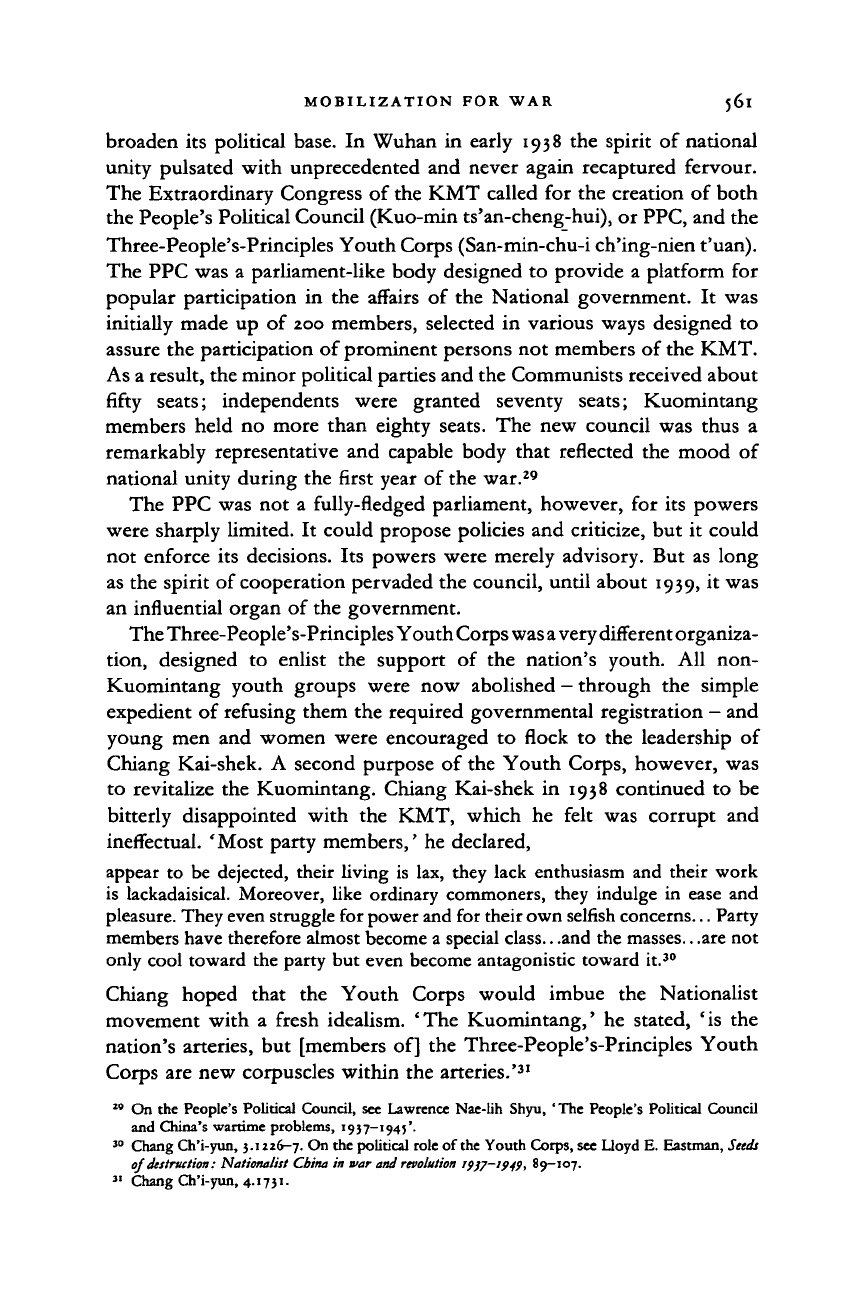
MOBILIZATION FOR WAR 561
broaden its political base. In Wuhan in early 1938 the spirit of national
unity pulsated with unprecedented and never again recaptured fervour.
The Extraordinary Congress of the KMT called for the creation of both
the People's Political Council (Kuo-min ts'an-cheng-hui), or PPC, and the
Three-People's-Principles Youth Corps (San-min-chu-i ch'ing-nien t'uan).
The PPC was a parliament-like body designed to provide a platform for
popular participation in the affairs of the National government. It was
initially made up of 200 members, selected in various ways designed to
assure the participation of prominent persons not members of the KMT.
As a result, the minor political parties and the Communists received about
fifty
seats;
independents were granted seventy seats; Kuomintang
members held no more than eighty seats. The new council was thus a
remarkably representative and capable body that reflected the mood of
national unity during the first year of the war.
29
The PPC was not a fully-fledged parliament, however, for its powers
were sharply limited. It could propose policies and criticize, but it could
not enforce its decisions. Its powers were merely advisory. But as long
as the spirit of cooperation pervaded the council, until about 1939, it was
an influential organ of the government.
The Three-People's-Principles Youth Corps was a very different organiza-
tion, designed to enlist the support of the nation's youth. All non-
Kuomintang youth groups were now abolished - through the simple
expedient of refusing them the required governmental registration - and
young men and women were encouraged to flock to the leadership of
Chiang Kai-shek. A second purpose of the Youth Corps, however, was
to revitalize the Kuomintang. Chiang Kai-shek in 1938 continued to be
bitterly disappointed with the KMT, which he felt was corrupt and
ineffectual. ' Most party members,' he declared,
appear to be dejected, their living is lax, they lack enthusiasm and their work
is lackadaisical. Moreover, like ordinary commoners, they indulge in ease and
pleasure. They
even
struggle for power and for their own selfish concerns... Party
members have therefore almost become a special
class..
.and the
masses..
.are
not
only cool toward the party but even become antagonistic toward it.
30
Chiang hoped that the Youth Corps would imbue the Nationalist
movement with a fresh idealism. 'The Kuomintang,' he stated, 'is the
nation's arteries, but [members of] the Three-People's-Principles Youth
Corps are new corpuscles within the arteries.'
31
20
On the
People's Political Council,
sec
Lawrence Nae-lih Shyu,
'
The People's Political Council
and China's wartime problems, 1937-1945'.
30
Chang Ch'i-yun, 3.1226-7. On the political role
of
the Youth Corps, see Lloyd
E.
Eastman, Seeds
ofdestruction: Nationalist China
in
war and
revolution
1937-1949, 89—107.
31
Chang Ch'i-yun, 4.1731.
Cambridge Histories Online © Cambridge University Press, 2008
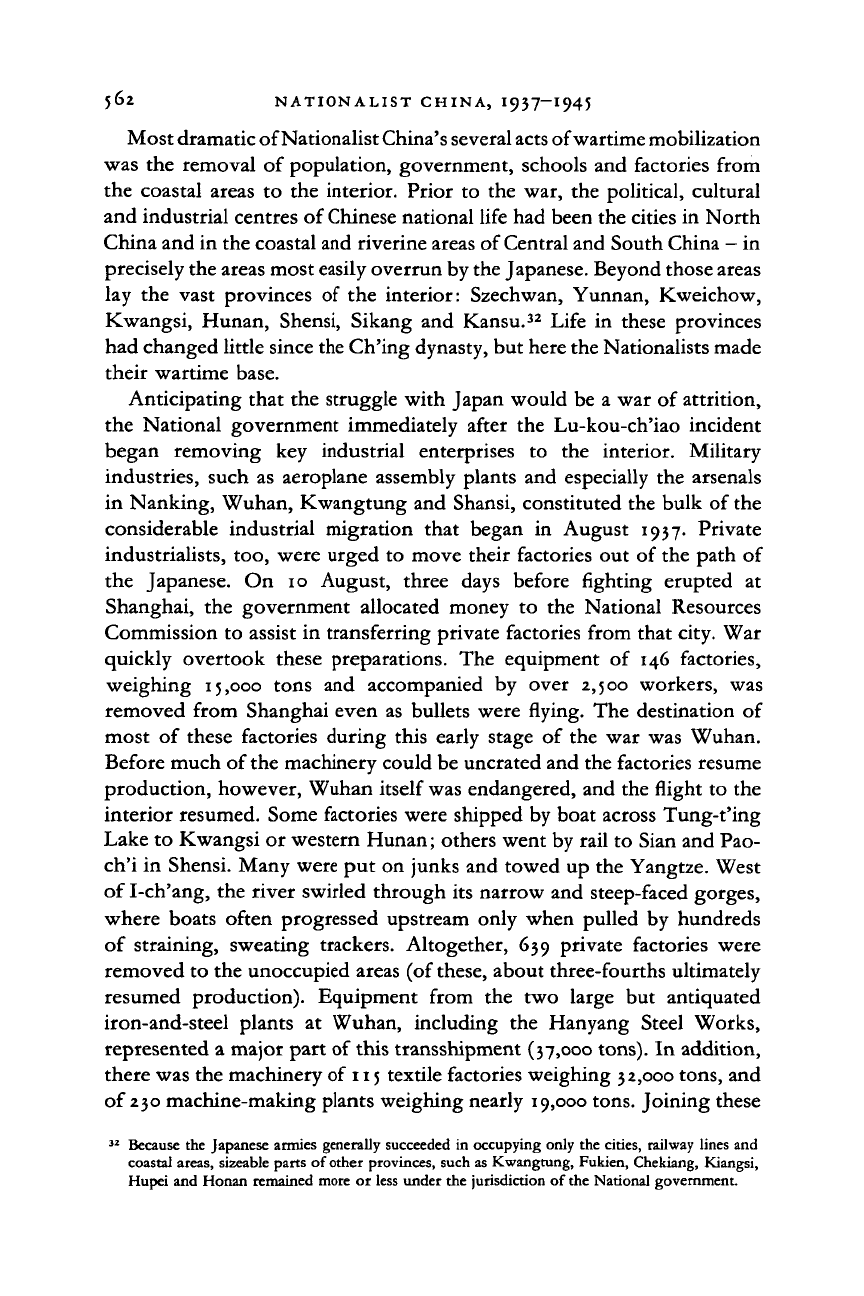
562 NATIONALIST CHINA, I937-I945
Most dramatic of Nationalist China's several
acts
of wartime mobilization
was the removal of population, government, schools and factories from
the coastal areas
to
the interior. Prior to the war, the political, cultural
and industrial centres of Chinese national life had been the cities in North
China and in the coastal and riverine areas of Central and South China
—
in
precisely the areas most easily overrun by the Japanese. Beyond those areas
lay the vast provinces
of
the interior: Szechwan, Yunnan, Kweichow,
Kwangsi, Hunan, Shensi, Sikang and Kansu.
32
Life
in
these provinces
had changed little since the Ch'ing dynasty, but here the Nationalists made
their wartime base.
Anticipating that the struggle with Japan would be a war of attrition,
the National government immediately after the Lu-kou-ch'iao incident
began removing
key
industrial enterprises
to the
interior. Military
industries, such as aeroplane assembly plants and especially the arsenals
in Nanking, Wuhan, Kwangtung and Shansi, constituted the bulk of the
considerable industrial migration that began
in
August 1937. Private
industrialists, too, were urged to move their factories out of the path of
the Japanese.
On 10
August, three days before fighting erupted
at
Shanghai, the government allocated money
to
the National Resources
Commission to assist in transferring private factories from that city. War
quickly overtook these preparations. The equipment
of
146 factories,
weighing 15,000 tons and accompanied
by
over 2,500 workers, was
removed from Shanghai even as bullets were flying. The destination of
most
of
these factories during this early stage
of
the war was Wuhan.
Before much of the machinery could be uncrated and the factories resume
production, however, Wuhan itself was endangered, and the flight to the
interior resumed. Some factories were shipped by boat across Tung-t'ing
Lake to Kwangsi or western Hunan; others went by rail to Sian and Pao-
ch'i in Shensi. Many were put on junks and towed up the Yangtze. West
of I-ch'ang, the river swirled through its narrow and steep-faced gorges,
where boats often progressed upstream only when pulled by hundreds
of straining, sweating trackers. Altogether, 639 private factories were
removed to the unoccupied areas (of
these,
about three-fourths ultimately
resumed production). Equipment from
the
two large
but
antiquated
iron-and-steel plants
at
Wuhan, including the Hanyang Steel Works,
represented a major part of this transshipment (37,000 tons). In addition,
there was the machinery of 115 textile factories weighing 32,000 tons, and
of 230 machine-making plants weighing nearly 19,000 tons. Joining these
32
Because the Japanese armies generally succeeded in occupying only the cities, railway lines and
coastal areas, sizeable parts of other provinces, such as Kwangtung, Fukien, Chekiang, Kiangsi,
Hupei and Honan remained more or less under the jurisdiction of the National government.
Cambridge Histories Online © Cambridge University Press, 2008
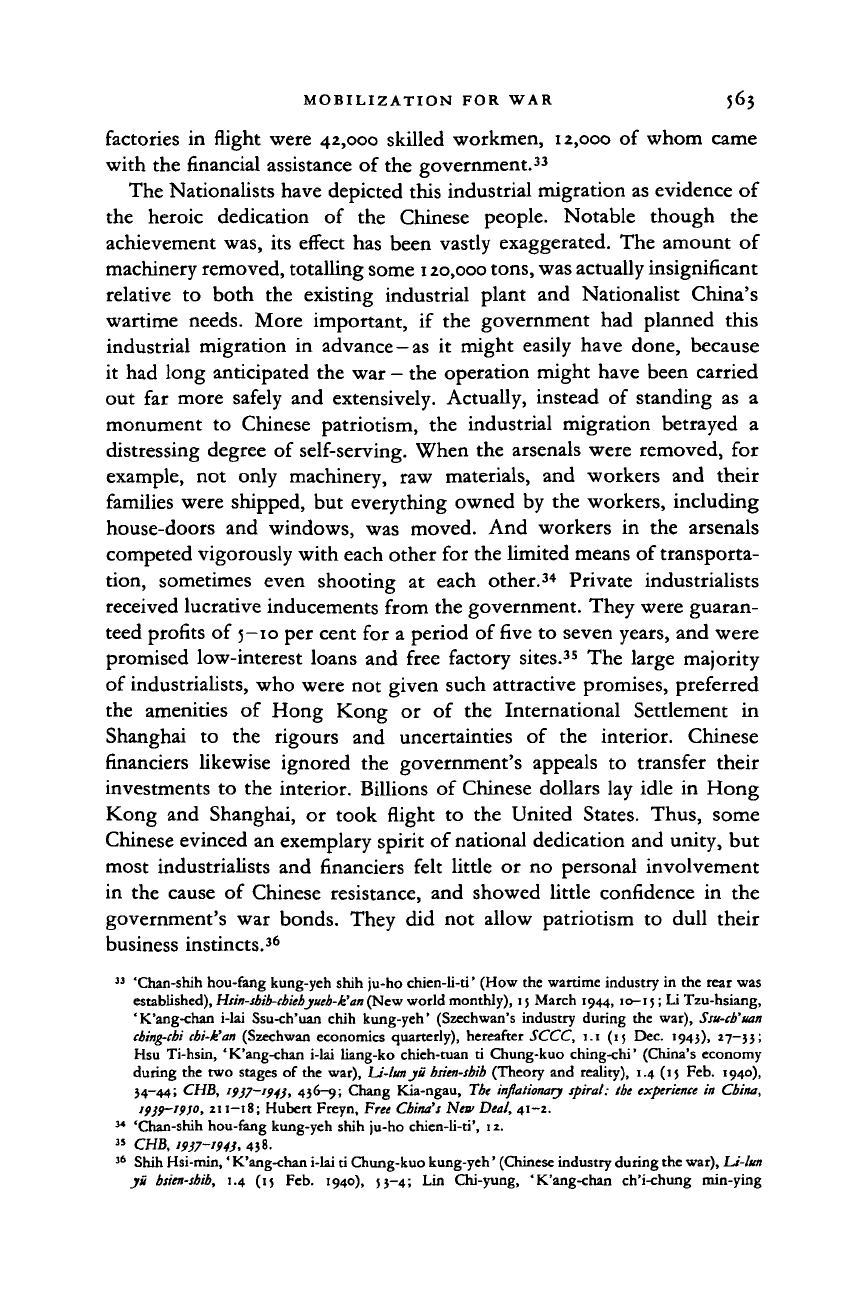
MOBILIZATION
FOR WAR 563
factories
in
flight were 42,000 skilled workmen, 12,000
of
whom came
with the financial assistance
of
the government.
33
The Nationalists have depicted this industrial migration as evidence of
the heroic dedication
of the
Chinese people. Notable though
the
achievement was, its effect has been vastly exaggerated. The amount
of
machinery removed, totalling some 120,000 tons, was actually insignificant
relative
to
both
the
existing industrial plant
and
Nationalist China's
wartime needs. More important,
if
the government
had
planned this
industrial migration
in
advance-as
it
might easily have done, because
it had long anticipated the war
-
the operation might have been carried
out
far
more safely and extensively. Actually, instead
of
standing
as a
monument
to
Chinese patriotism,
the
industrial migration betrayed
a
distressing degree
of
self-serving. When the arsenals were removed,
for
example,
not
only machinery,
raw
materials,
and
workers
and
their
families were shipped, but everything owned by the workers, including
house-doors
and
windows,
was
moved. And workers
in the
arsenals
competed vigorously with each other for the limited means of transporta-
tion, sometimes even shooting
at
each other.
34
Private industrialists
received lucrative inducements from the government. They were guaran-
teed profits
of
5-10 per cent for
a
period
of
five to seven years, and were
promised low-interest loans and free factory sites.
35
The large majority
of industrialists, who were not given such attractive promises, preferred
the amenities
of
Hong Kong
or of the
International Settlement
in
Shanghai
to the
rigours
and
uncertainties
of the
interior. Chinese
financiers likewise ignored
the
government's appeals
to
transfer their
investments
to
the interior. Billions
of
Chinese dollars lay idle
in
Hong
Kong
and
Shanghai,
or
took flight
to the
United States. Thus, some
Chinese evinced an exemplary spirit of national dedication and unity, but
most industrialists and financiers felt little
or no
personal involvement
in the cause
of
Chinese resistance,
and
showed little confidence
in the
government's war bonds. They
did not
allow patriotism
to
dull their
business instincts.
36
33
'Chan-shih hou-fang kung-yeh shih ju-ho chien-li-ti' (How the wartime industry in the rear was
established),
Hsin-sbib-chiebyueb-k'an
(New world monthly), 15 March 1944, 10-15; Li Tzu-hsiang,
'K'ang-chan i-lai Ssu-ch'uan chih kung-yeh' (Szechwan's industry during the war),
Ssu-cb'uan
cbing-cbi cbi-k'an
(Szechwan economics quarterly), hereafter SCCC,
1.1
(15 Dec. 1943),
27—33;
Hsu Ti-hsin, 'K'ang-chan i-lai liang-ko chieh-tuan
ti
Chung-kuo ching-chi' (China's economy
during the two stages
of
the war),
U-lunju
hsicn-shib
(Theory and reality),
1.4
(15 Feb. 1940),
34—44;
CHB,
19)7-194), 436-9; Chang Kia-ngau,
The
inflationary spiral:
the
experience
in
China,
'9)9~'9J°> 211-18; Hubert Freyn, Free China's
New
Deal, 41-2.
34
'Chan-shih hou-fang kung-yeh shih ju-ho chien-li-ti', 12.
" CHB, i9)7-'94), 43»-
36
Shih Hsi-min,' K'ang-chan i-lai ti Chung-kuo kung-yeh' (Chinese industry during the war),
U-lim
yu
bsien-sbib,
1.4 (15 Feb.
1940), 53-4;
Lin
Chi-yung, 'K'ang-chan ch'i-chung min-ying
Cambridge Histories Online © Cambridge University Press, 2008

564 NATIONALIST CHINA, I937-I945
Universities also joined the migration
to
the interior. Since they had
been the fountainhead of opposition to Japanese imperialism, the Japanese
army wreaked a special vengeance upon them. On 29 July 1937 Japanese
planes bombed Nankai University
in
Tientsin. The next day, Japanese
artillery pummelled the remains of the campus. Finally, using kerosene,
they set flames to the ruins in order to complete the destruction of this
anti-Japanese centre. Tsing-hua University in Peiping was first systemati-
cally stripped by Japanese looters, and then its buildings were converted
into
a
barracks, hospital, bar, brothel and stables for the imperial army.
Other universities,
in
Shanghai, Nanking, Wuhan and Canton, were
repeatedly bombed.
37
Students and professors became
a
part
of
the tide
of
refugees
to
the
interior. By late 1939, only six of the universities, colleges and vocational
schools originally in Japanese-occupied territory remained there. Of the
rest, fully fifty-two educational institutions had fled into the interior, while
twenty-five took refuge in the foreign concessions or Hong Kong. Those
that joined the exodus to the west sometimes had to travel 2—3,000 miles
before finding a wartime haven. Three of China's most noted universities
(Tsing-hua, Peita and Nankai),
for
example, first fled
to
Changsha
in
Hunan, where they established
a
joint campus.
By
February 1938,
however,
the
students and faculty
had to
move again, this time
to
Kunming, the capital of Yunnan. One group went by rail and ship by
way of Canton and Hanoi. The second group, consisting of 257 students
and eleven professors, trekked over a thousand miles, mostly on foot,
to
the new campus.
The war exacted a heavy toll on the educational establishment. Seventeen
institutions had been forced
to
close; thousands
of
youths had their
education halted. Some students, of course, stayed at home, but hundreds
of others joined the Nationalist army
or
the Communist guerrillas,
or
participated
in
troop entertainment
or
nursing corps. For those who
continued their studies, conditions in the refugee universities were often
wretched. There were severe shortages of textbooks, library materials and
scientific apparatus. Professors frequently had lost their lecture notes and
other reference materials. Both students and professors, too, found living
conditions harsh. Temples, ancestral halls
or
mud-and-wattle huts were
ch'ang-k'uang ch'ien-Ch'uan chien-shu' (Summary account
of
the move
of
privately-owned
factories and mining
to
Szechwan during the war),
Ssu-ctiuan wen-bsien
(Records of Szechwan),
62(1 Oct. 1967), 4-7; Freyn,
Free China's
New
Deal,
42-3; Edgar Snow,
The
battle for Asia, 149;
Barbara W. Tuchman, Stilwelland
the American experience
in
China,
rfri-jj, 184.
" On education during the war, see Hubert Freyn,
Chinese education
in the war; William P. Fenn,
The effect
of
the Japanese invasion on higher education
in
China; John Israel, 'Southwest Associated
University: survival as an ultimate value', and Ou Tsuin-chen',
'
Education in wartime China',
both in Paul K. T. Sih, ed.
Nationalist
China.
Cambridge Histories Online © Cambridge University Press, 2008
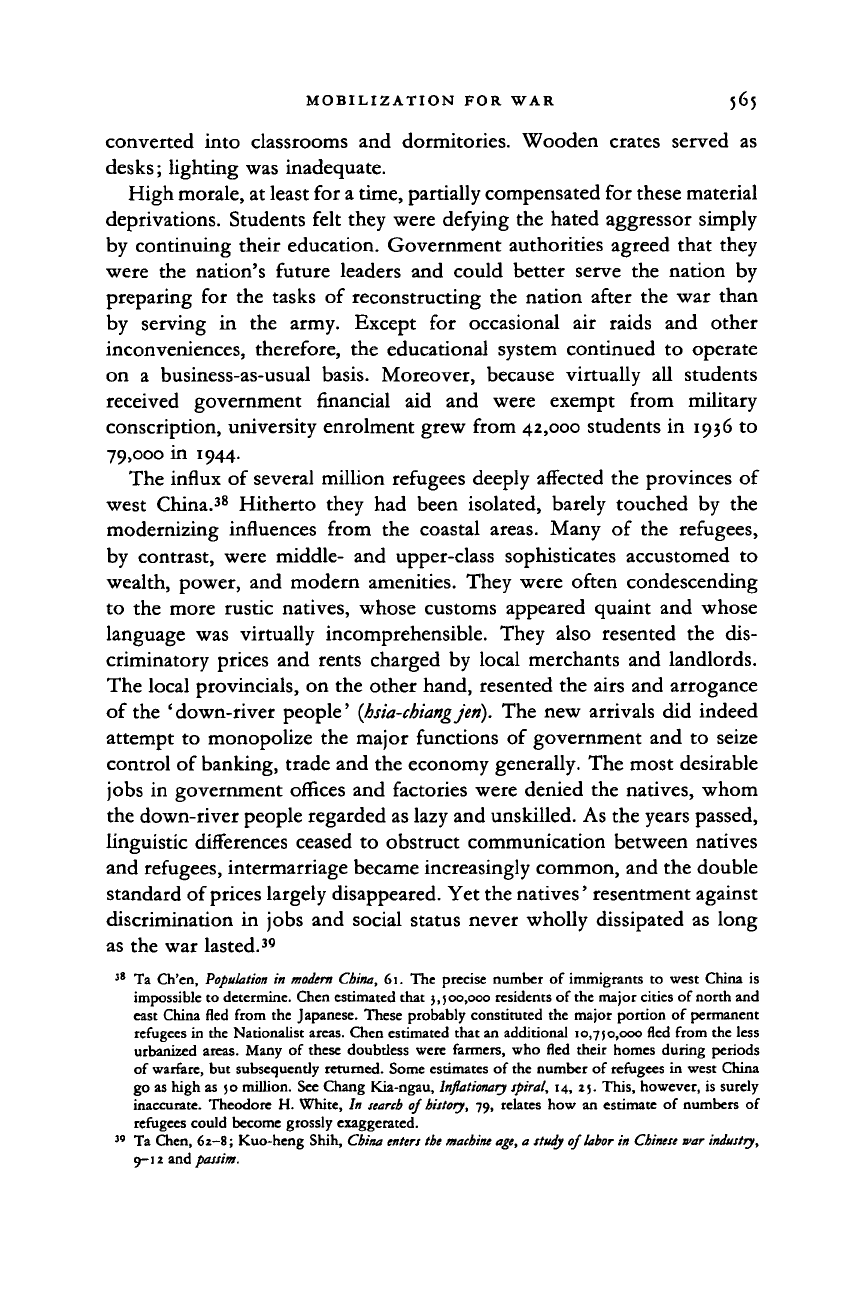
MOBILIZATION
FOR WAR 565
converted into classrooms
and
dormitories. Wooden crates served
as
desks;
lighting was inadequate.
High morale, at least for a time, partially compensated for these material
deprivations. Students felt they were defying the hated aggressor simply
by continuing their education. Government authorities agreed that they
were
the
nation's future leaders
and
could better serve
the
nation
by
preparing
for the
tasks
of
reconstructing
the
nation after
the war
than
by serving
in the
army. Except
for
occasional
air
raids
and
other
inconveniences, therefore,
the
educational system continued
to
operate
on
a
business-as-usual basis. Moreover, because virtually
all
students
received government financial
aid and
were exempt from military
conscription, university enrolment grew from 42,000 students
in
1936
to
79,000
in
1944.
The influx
of
several million refugees deeply affected
the
provinces
of
west China.
38
Hitherto they
had
been isolated, barely touched
by the
modernizing influences from
the
coastal areas. Many
of the
refugees,
by contrast, were middle-
and
upper-class sophisticates accustomed
to
wealth, power,
and
modern amenities. They were often condescending
to
the
more rustic natives, whose customs appeared quaint
and
whose
language
was
virtually incomprehensible. They also resented
the dis-
criminatory prices
and
rents charged
by
local merchants
and
landlords.
The local provincials,
on
the other hand, resented the airs and arrogance
of the
'
down-river people'
{hsia-chiangjen).
The new arrivals
did
indeed
attempt
to
monopolize
the
major functions
of
government
and to
seize
control
of
banking, trade and the economy generally. The most desirable
jobs
in
government offices
and
factories were denied
the
natives, whom
the down-river people regarded as lazy and unskilled. As the years passed,
linguistic differences ceased
to
obstruct communication between natives
and refugees, intermarriage became increasingly common, and the double
standard of prices largely disappeared. Yet the natives' resentment against
discrimination
in
jobs
and
social status never wholly dissipated
as
long
as the war lasted.
39
38
Ta
Ch'cn,
Population
in
modern
China,
61.
The
precise number
of
immigrants
to
west China
is
impossible to determine. Chen estimated that 3,;00,000 residents
of
the major cities
of
north and
east China fled from the Japanese. These probably constituted
the
major portion
of
permanent
refugees in the Nationalist areas. Chen estimated that an additional 10,750,000 fled from the less
urbanized areas. Many
of
these doubtless were farmers,
who
fled their homes during periods
of warfare, but subsequently returned. Some estimates
of
the number
of
refugees
in
west China
go as high as 50 million. See Chang Kia-ngau,
Inflationary
spiral,
14, 25. This, however,
is
surely
inaccurate. Theodore
H.
White, In
search
of
history,
79,
relates how
an
estimate
of
numbers
of
refugees could become grossly exaggerated.
35
Ta
Chen, 62-8; Kuo-heng Shih, China enters the
machine
age,
a
study
of
labor
in
Chinese
war industry,
9-12 and passim.
Cambridge Histories Online © Cambridge University Press, 2008
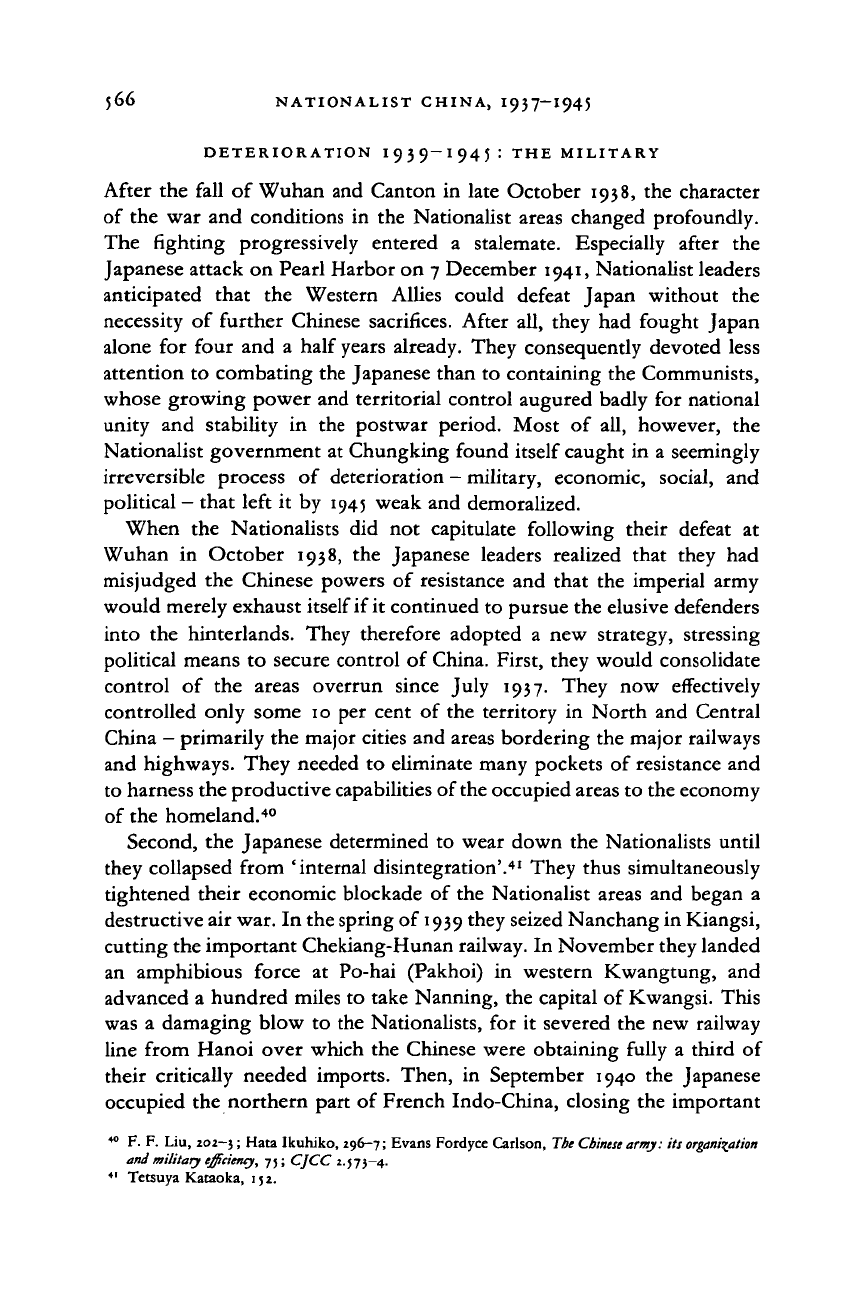
566 NATIONALIST CHINA, 1937-1945
DETERIORATION I939-I945 : THE MILITARY
After
the
fall
of
Wuhan
and
Canton
in
late October 1938,
the
character
of
the war and
conditions
in the
Nationalist areas changed profoundly.
The fighting progressively entered
a
stalemate. Especially after
the
Japanese attack
on
Pearl Harbor on 7 December
1941,
Nationalist leaders
anticipated that
the
Western Allies could defeat Japan without
the
necessity
of
further Chinese sacrifices. After
all,
they
had
fought Japan
alone
for
four
and a
half years already. They consequently devoted less
attention
to
combating the Japanese than
to
containing
the
Communists,
whose growing power and territorial control augured badly
for
national
unity
and
stability
in the
postwar period. Most
of all,
however,
the
Nationalist government
at
Chungking found itself caught
in a
seemingly
irreversible process
of
deterioration
-
military, economic, social,
and
political
—
that left
it by
1945 weak
and
demoralized.
When
the
Nationalists
did not
capitulate following their defeat
at
Wuhan
in
October
1938, the
Japanese leaders realized that they
had
misjudged
the
Chinese powers
of
resistance
and
that
the
imperial army
would merely exhaust itself
if
it continued
to
pursue the elusive defenders
into
the
hinterlands. They therefore adopted
a new
strategy, stressing
political means
to
secure control
of
China. First, they would consolidate
control
of the
areas overrun since July
1937.
They
now
effectively
controlled only some
10 per
cent
of
the territory
in
North
and
Central
China
-
primarily
the
major cities
and
areas bordering
the
major railways
and highways. They needed
to
eliminate many pockets
of
resistance
and
to harness the productive capabilities of the occupied areas to the economy
of the homeland.
40
Second,
the
Japanese determined
to
wear down
the
Nationalists until
they collapsed from 'internal disintegration'.
41
They thus simultaneously
tightened their economic blockade
of
the Nationalist areas
and
began
a
destructive air war.
In
the spring
of
1939
they seized Nanchang in Kiangsi,
cutting the important Chekiang-Hunan railway.
In
November they landed
an amphibious force
at
Po-hai (Pakhoi)
in
western Kwangtung,
and
advanced
a
hundred miles
to
take Nanning,
the
capital
of
Kwangsi. This
was
a
damaging blow
to the
Nationalists,
for it
severed
the new
railway
line from Hanoi over which
the
Chinese were obtaining fully
a
third
of
their critically needed imports. Then,
in
September
1940 the
Japanese
occupied
the
northern part
of
French Indo-China, closing
the
important
40
F. F.
Liu, 202—3• Hata Ikuhiko, 296-7; Evans Fordyce Carlson, The Chinese army:
its
organisation
and military efficiency,
7;;
CJCC 2.573-4.
41
Tetsuya Kacaoka,
152.
Cambridge Histories Online © Cambridge University Press, 2008
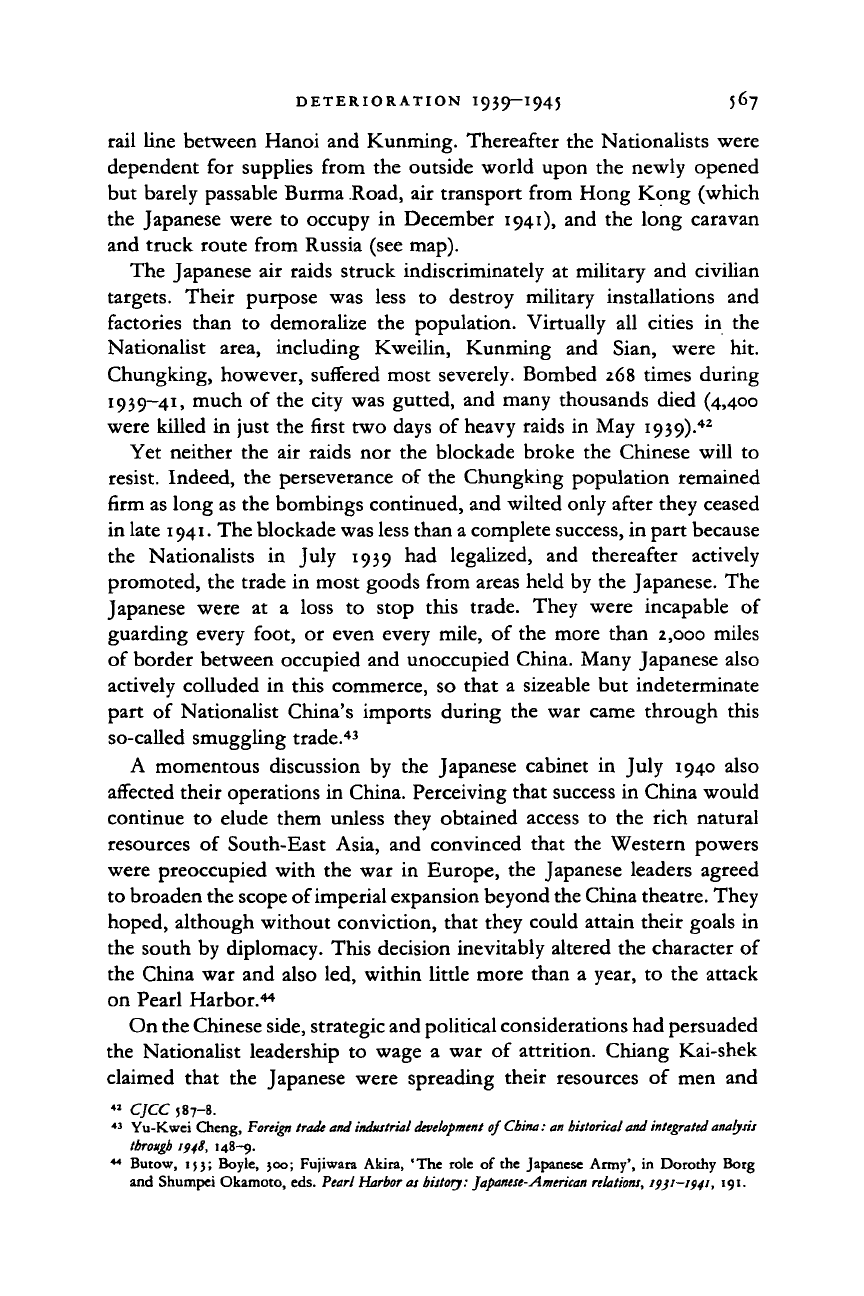
DETERIORATION I939—1945 567
rail line between Hanoi and Kunming. Thereafter the Nationalists were
dependent for supplies from the outside world upon the newly opened
but barely passable Burma Road, air transport from Hong Kong (which
the Japanese were to occupy in December 1941), and the long caravan
and truck route from Russia (see map).
The Japanese air raids struck indiscriminately at military and civilian
targets. Their purpose was less to destroy military installations and
factories than to demoralize the population. Virtually all cities in the
Nationalist area, including Kweilin, Kunming and Sian, were hit.
Chungking, however, suffered most severely. Bombed 268 times during
1939—41,
much of the city was gutted, and many thousands died (4,400
were killed in just the first two days of heavy raids in May 1939).
42
Yet neither the air raids nor the blockade broke the Chinese will to
resist. Indeed, the perseverance of the Chungking population remained
firm as long as the bombings continued, and wilted only after they ceased
in late
1941.
The blockade was less than a complete success, in part because
the Nationalists in July 1939 had legalized, and thereafter actively
promoted, the trade in most goods from areas held by the Japanese. The
Japanese were at a loss to stop this trade. They were incapable of
guarding every foot, or even every mile, of the more than 2,000 miles
of border between occupied and unoccupied China. Many Japanese also
actively colluded in this commerce, so that a sizeable but indeterminate
part of Nationalist China's imports during the war came through this
so-called smuggling trade.
43
A momentous discussion by the Japanese cabinet in July 1940 also
affected their operations in China. Perceiving that success in China would
continue to elude them unless they obtained access to the rich natural
resources of South-East Asia, and convinced that the Western powers
were preoccupied with the war in Europe, the Japanese leaders agreed
to broaden the scope of imperial expansion beyond the China theatre. They
hoped, although without conviction, that they could attain their goals in
the south by diplomacy. This decision inevitably altered the character of
the China war and also led, within little more than a year, to the attack
on Pearl Harbor.
44
On the Chinese
side,
strategic and political considerations had persuaded
the Nationalist leadership to wage a war of attrition. Chiang Kai-shek
claimed that the Japanese were spreading their resources of men and
"
CJCC 587-8.
43
Yu-Kwei Cheng, Foreign trade and industrial development
of
China: an historical and integrated analysis
through 194S, 148-9.
44
Butow, 153; Boyle, joo; Fujiwata Akira, "The role
of
the Japanese Army',
in
Dorothy Borg
and Shumpei Okamoto, eds. Pearl Harbor as history: Japanese-American relations, ipjt—if^i,
191.
Cambridge Histories Online © Cambridge University Press, 2008

NATIONALIST CHINA, 1937-1945
equipment too thin by advancing across the expanse of China.' The longer
our enemy struggles, the more he involves himself in difficulties; while
the longer we struggle, the stronger and more determined we become. '
45
Chiang, like the Japanese, also wished to avoid decisive battles, because
he anticipated that the Western Allies would ultimately be drawn into the
struggle against Japan. Initially he looked to the Allies merely for material
aid and for economic sanctions against Japan. But after Pearl Harbor
-
news
of
which was greeted joyously
in
Chungking
—
he expected that
Great Britain
and
especially
the
United States, with
its
enormous
technological resources, would assume
the
major burden
of
defeating
Japan. By 1943, the American ambassador to China, Clarence E. Gauss,
observed that' The Chinese have persuaded themselves that [they] are too
tired and too worn and too ill-equipped to make greater effort, especially
when such effort may not be necessary; and that [they] can sit back, hold-
ing what they have against the Japanese, and concentrate their planning
upon China's post-war political and economic problems.
>46
The chief political problem that distracted the Nationalists' attention
from the Japanese was the growing friction with the Chinese Communists.
After the New Fourth Army incident
in
January 1941 (see p. 665)
the
united front had virtually ceased to exist. Influential Nationalist leaders
—
most notably
the
minister
of
war,
Ho
Ying-ch'in,
and the
party
apparatchik, Ch'en Li-fu
-
at various times stridently advocated
a
final
extermination campaign against
the
Communists. Chiang Kai-shek
resisted these pressures,
in
large part because
he
feared that the Allies
would cease aiding the Nationalist army
if
it became openly involved
in
civil war.
Yet,
since mid-1939,
he had
committed many
of
his best
troops
-
at various times between 150,000 and 500,000-to blockading
the Communists' base in the north-west.
47
Although both Nationalists and Japanese after late 1938 were content
to wage
a
war
of
attrition, fighting
by no
means abated completely.
Occasionally
the
Japanese launched
an
offensive
to
attain limited
objectives. In June 1940, for example, they seized the important Yangtze
River port of I-ch'ang in order to staunch the flow of goods between the
rice-bowl provinces
of
Central China and Chungking and
to
obtain
an
air base closer to the Nationalist area. In the summer of
1942,
after General
James H. Doolittle's bombing
of
Tokyo,
the
Japanese struck into
Chekiang and Kiangsi with 100,000 troops to destroy air bases that might
45
Chiang Kai-shek, Resistance and
reconstruction,
108.
46
FRltf,
194},
China,
142.
47
Charles
F.
Romanus
and
Riley Sunderland, Stilvell's command problems,
303;
F. F. Liu,
205;
L.
P.
Van Slyke, ed.
Tie
Chinese Communist movement:
a
report of the United States
War
Department,
July 194J, 71-2.
Cambridge Histories Online © Cambridge University Press, 2008
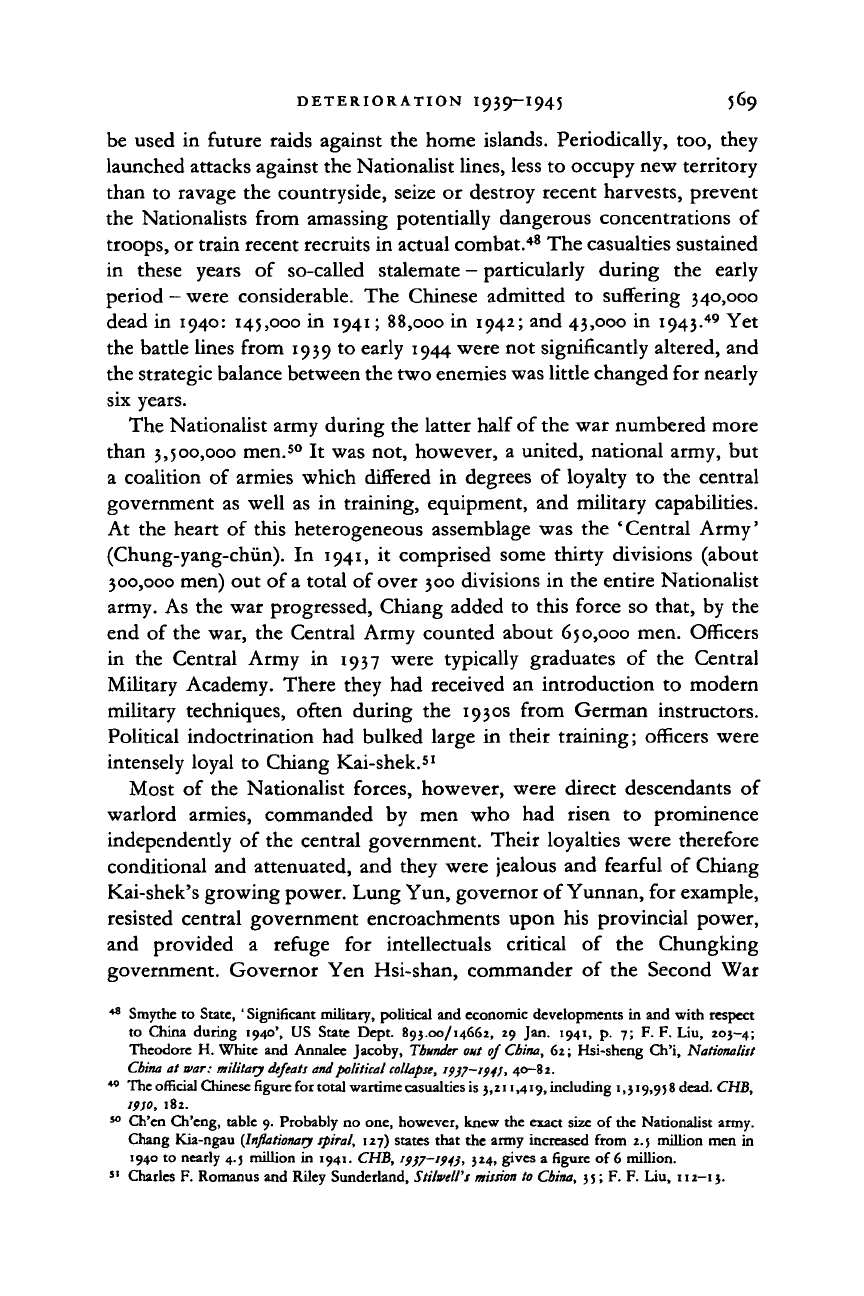
DETERIORATION I939-I945 569
be used in future raids against the home islands. Periodically, too, they
launched attacks against the Nationalist lines, less to occupy new territory
than to ravage the countryside, seize or destroy recent harvests, prevent
the Nationalists from amassing potentially dangerous concentrations of
troops, or train recent recruits in actual combat.
48
The casualties sustained
in these years of so-called stalemate - particularly during the early
period
—
were considerable. The Chinese admitted to suffering 340,000
dead in 1940: 145,000 in 1941; 88,000 in 1942; and 43,000 in
1943.
49
Yet
the battle lines from 1939 to early 1944 were not significantly altered, and
the strategic balance between the two enemies was little changed for nearly
six years.
The Nationalist army during the latter half of the war numbered more
than 3,500,000 men.
50
It was not, however, a united, national army, but
a coalition of armies which differed in degrees of loyalty to the central
government as well as in training, equipment, and military capabilities.
At the heart of this heterogeneous assemblage was the ' Central Army'
(Chung-yang-chiin). In 1941, it comprised some thirty divisions (about
300,000 men) out of a total of over 300 divisions in the entire Nationalist
army. As the war progressed, Chiang added to this force so that, by the
end of the war, the Central Army counted about 650,000 men. Officers
in the Central Army in 1937 were typically graduates of the Central
Military Academy. There they had received an introduction to modern
military techniques, often during the 1930s from German instructors.
Political indoctrination had bulked large in their training; officers were
intensely loyal to Chiang Kai-shek.
51
Most of the Nationalist forces, however, were direct descendants of
warlord armies, commanded by men who had risen to prominence
independently of the central government. Their loyalties were therefore
conditional and attenuated, and they were jealous and fearful of Chiang
Kai-shek's growing power. Lung Yun, governor of Yunnan, for example,
resisted central government encroachments upon his provincial power,
and provided a refuge for intellectuals critical of the Chungking
government. Governor Yen Hsi-shan, commander of the Second War
48
Smythe to State,
'
Significant military, political and economic developments in and with respect
to China during 1940', US State Dept. 893.00/14662, 29 Jan. 1941, p. 7; F. F. Liu, 205-4;
Theodore H. White and Annalee Jacoby,
Thunder
out of
China,
62; Hsi-sheng Ch'i,
Nationalist
China
at war:
military defeats
and
political
collapse,
19)7-194), 40-82.
45
The official Chinese
figure
for total wartime casualties is 5,211,419, including 1,519,958 dead. CHB,
19
jo,
182.
50
Ch'en
Ch'eng,
table 9. Probably no one, however, knew the exact size of the Nationalist army.
Chang
Kia-ngau {Inflationary spiral, 127) states that the army increased from 2.} million men in
1940
to nearly 4.J million in 1941. CHB,
19)7-194},
$24, gives a figure of 6
million.
51
Charles F. Romanus and Riley Sunderland, Stilwell's mission to
China,
35; F. F. Liu,
112—13.
Cambridge Histories Online © Cambridge University Press, 2008
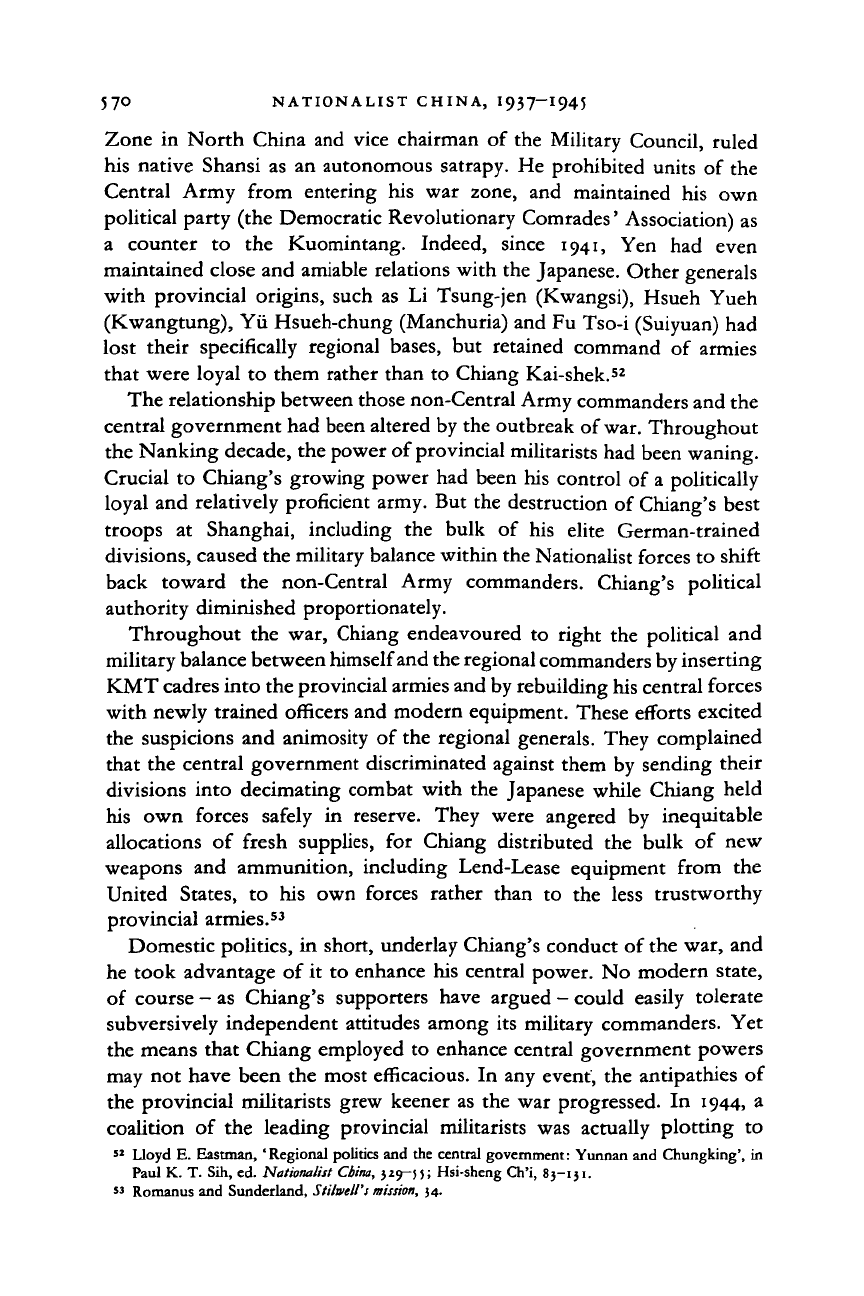
570 NATIONALIST CHINA, I937-I945
Zone
in
North China and vice chairman
of
the Military Council, ruled
his native Shansi as an autonomous satrapy. He prohibited units
of
the
Central Army from entering
his war
zone,
and
maintained
his own
political party (the Democratic Revolutionary Comrades' Association) as
a counter
to the
Kuomintang. Indeed, since 1941,
Yen had
even
maintained close and amiable relations with the Japanese. Other generals
with provincial origins, such
as Li
Tsung-jen (Kwangsi), Hsueh Yueh
(Kwangtung), Yii Hsueh-chung (Manchuria) and Fu Tso-i (Suiyuan) had
lost their specifically regional bases,
but
retained command
of
armies
that were loyal
to
them rather than to Chiang Kai-shek.
52
The relationship between those non-Central Army commanders and the
central government had been altered by the outbreak of war. Throughout
the Nanking decade, the power of provincial militarists had been waning.
Crucial
to
Chiang's growing power had been his control
of
a politically
loyal and relatively proficient army. But the destruction of Chiang's best
troops
at
Shanghai, including
the
bulk
of his
elite German-trained
divisions, caused the military balance within the Nationalist forces to shift
back toward
the
non-Central Army commanders. Chiang's political
authority diminished proportionately.
Throughout
the
war, Chiang endeavoured
to
right the political and
military balance between himself and the regional commanders by inserting
KMT cadres into the provincial armies and by rebuilding his central forces
with newly trained officers and modern equipment. These efforts excited
the suspicions and animosity
of
the regional generals. They complained
that the central government discriminated against them by sending their
divisions into decimating combat with the Japanese while Chiang held
his
own
forces safely
in
reserve. They were angered
by
inequitable
allocations
of
fresh supplies,
for
Chiang distributed
the
bulk
of
new
weapons
and
ammunition, including Lend-Lease equipment from
the
United States,
to his
own forces rather than
to the
less trustworthy
provincial armies.
53
Domestic politics, in short, underlay Chiang's conduct of the war, and
he took advantage
of
it to enhance his central power. No modern state,
of course
-
as Chiang's supporters have argued
-
could easily tolerate
subversively independent attitudes among its military commanders. Yet
the means that Chiang employed to enhance central government powers
may not have been the most efficacious.
In
any event, the antipathies of
the provincial militarists grew keener as the war progressed.
In
1944,
a
coalition
of
the leading provincial militarists was actually plotting
to
52
Lloyd
E.
Eastman, 'Regional politics and the central government: Yunnan and Chungking',
in
Paul
K. T.
Sih, ed. Nationalist China,
329—
55;
Hsi-sheng Ch'i, 83-131.
53
Romanus and Sunderland, Stilwell's mission, 34.
Cambridge Histories Online © Cambridge University Press, 2008
